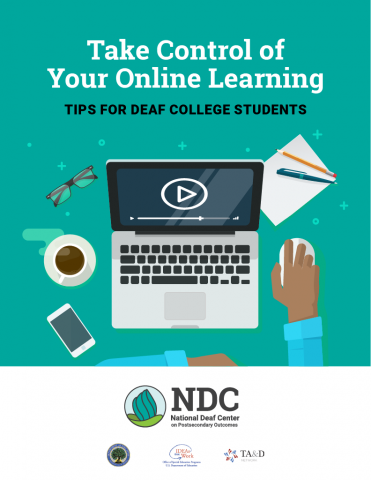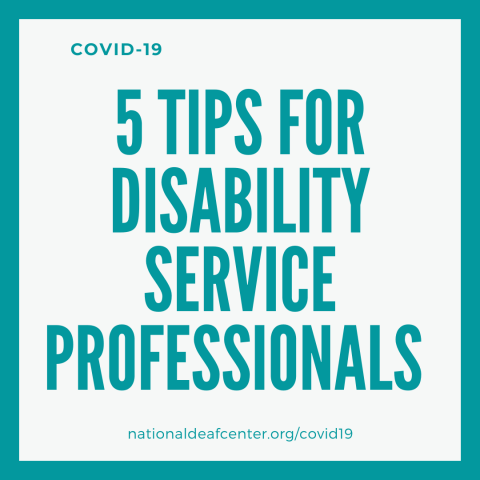Deafverse Can Help Deaf Teens Connect and Learn from Home

For deaf middle and high school students, there are very few accessible online games or resources. That’s why Deafverse, the first-ever American Sign Language (ASL) accessible online game for deaf teenagers, is the go-to game for at-home learning. [Disponible en español]
Join Us for a Live Student Panel
The National Deaf Center of Postsecondary Outcomes (NDC) has assembled a live panel of deaf undergraduate and graduate students to discuss their online learning experiences and tips for strengthening access and self-care during this stressful time. During the panel, students are invited to participate and share their own online learning experiences.
Checklist for Teaching Deaf Students Online
As schools across the country transition to online courses in response to COVID-19, educators are working to ensure students receive the same quality education they received in the classroom. For deaf students, this means all course content must be accessible and equitable.
This checklist for teaching deaf students online helps educators meet their needs and ensures compliance with the law. Stay tuned for a new National Deaf Center resource in the coming weeks, which will expand the checklist with more detailed tips and advice.
Take Control of Your Online Learning: Tips for Deaf College Students

COVID-19 has made colleges and universities around the United States switch to online learning for everyone — including deaf students like you.
Whether you have taken an online class before or are new to this, remember: accommodations don’t stop because you are now learning remotely. Here are some strategies for you to take control of your online learning and set yourself up for success. [Disponible en español]
5 Tips for Disability Service Professionals to Provide Accessibility in Online Classes

Disability service professionals are on the front lines — bringing their specialized knowledge, unique strengths, and necessary insights — to ensure that all classes are accessible to deaf and hard of hearing students as colleges and schools move them online in response to the Coronavirus disease (COVID-19). [Disponible en español]
Transition/Life Skills Checklists and Resources

Recently, Casey Brown, Director of the Arkansas Career Center at the Arkansas School for the Deaf, posted a question to the NDC listserv community asking for resources, checklists and assessments for transition and career exploration. We have combined the resources shared on this thread, resources from past listserv discussions on life skills, and information from our Self-Determination Task Force.
New Summer Program in Virginia to Show #DeafSuccess in Action

The Virginia Engage for Change | state team leaders Mary Nunnally, Wanda Council, and Traci Branch plan a fun and engaging summer program, Map Your Future 2020, targeted toward deaf high school students.
Family Support for Deaf Teens: A Roadmap to Success

As deaf children grow into teenagers, they begin to take a more active role in decision-making and responsibilities. Families are often unaware of strategies to support their deaf teen on becoming more independent. The role of family members is vital in ensuring deaf youth are prepared for life after high school. It’s an overwhelming but exciting time for both families and deaf teens.
‘Begrudging Tolerance’: New Report Reveals Deaf Students’ Experience On Campus
“There has been no institutional interest in learning how to become more deaf friendly. The attitude is one of begrudging tolerance at best.”
Deaf students across the country echoed this student’s story in the 2018-2019 Deaf College Student National Accessibility Report, “ACCESS Is More Than Accommodations,” released today by the National Deaf Center on Postsecondary Outcomes.
Featuring the Field: At Rocky Mountain Deaf School, Making Coffee Leads to Employment Opportunities

Heather Hapke from Rocky Mountain Deaf School agreed to share details about the school’s job training program, which includes an on-campus coffee shop, job shadowing and internships, a summer program, and more.
Mental Health for Deaf People

Valentine’s Day is around the corner, which can bring with it additional anxiety, depression and other stress about romance and relationships. Research shows that deaf people are more likely to struggle socially, emotionally and with other issues impacting mental health.
5 Tools for Disability Service Providers at Colleges and Universities Serving Deaf Students

A new semester can be overwhelming, but NDC is here with you. NDC can help streamline procedures to enhance disability services offices working with deaf students, with guides to help you build request forms, create a student absence policy and more.





